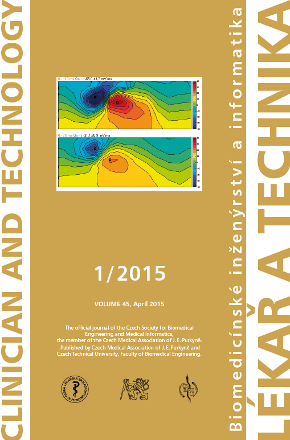UTILITY OF QRS ISOINTEGRAL MAPS IN LEFT VENTRICULAR HYPERTROPHY
Keywords:
body surface potential mapping, isointegral map, QRS complex, hypertension, left ventricular hypertrophyAbstract
Cardiac hypertrophy is an increase in the mass of the heart because of the enlargement of existing muscle fibres. It can be diagnosed in different ways including electrocardiographic body surface mapping. The aim of this paper is to give a brief qualitative and quantitative overview of the QRS isointegral maps in the left ventricular hypertrophy based on our original results as well as on published results. Electrocardiograms were recorded and QRS isointegral maps were constructed using the 24-lead system after Barr in different groups of patients with hypertension and patients with echocardiographically established left ventricular hypertrophy. Values of patients´ map extrema were compared with those of control subjects without cardiovascular diseases and also correlated with selected echocardiographic parameters. Increased as well as decreased values of extrema were found in patients compared to controls. Several extrema correlated well with left ventricular echocardiographic dimensions. In our studies, we found no significant changes of the QRS complex between controls and patients, although the peak-to-peak values increased with increasing left ventricular mass. This is in good agreement with some published data obtained with different lead systems. The disagreement in the results of other papers could be caused by differently defined groups of patients, a different aetiology of hypertrophy, racial differences, the possible influence of obesity, sex, and/or age. Despite these facts, considering both anatomical and electrical remodelling in the left ventricular hypertrophy, electrocardiographic body surface mapping is a useful method for the evaluation of such patients. The obtained detailed information can be valuable in understanding electrophysiological changes and consequences in left ventricular hypertrophy, and current clinical management of patients.
Downloads
Published
Issue
Section
License
Copyright (c) 2017 Katarína Kozlíková

This work is licensed under a Creative Commons Attribution 4.0 International License.
Authors who publish with this journal agree to the following terms:
- Authors retain copyright and grant the journal right of the first publication with the work simultaneously licensed under a Creative Commons Attribution License (https://creativecommons.org/licenses/by/4.0/) that allows others to share the work with an acknowledgment of the work's authorship and initial publication in CTJ.
- Authors are able to enter into separate, additional contractual arrangements for the non-exclusive distribution of the journal’s published version of the work (e.g., post it to an institutional repository or publish it in a book), with an acknowledgment of its initial publication in this journal.
- Authors are permitted and encouraged to post their work online (e.g., in institutional repositories or on their website or ResearchGate) prior to and during the submission process, as it can lead to productive exchanges.
CTJ requires that all of the content of the manuscript has been created by its respective authors or that permission to use a copyrighted material has been obtained by the authors before submitting the manuscript to CTJ. CTJ requires that authors have not used any copyrighted material illegally, as for example a picture from another journal or book, a photo, etc. It is the author’s responsibility to use only materials not violating the copyright law. When in doubt, CTJ may ask the authors to supply the pertinent permission or agreement about the use of a copyrighted material.
The opinions expressed in CTJ articles are those of authors and do not necessarily reflect the views of the publishers or the Czech Society for Biomedical Engineering and Medical Informatics.


